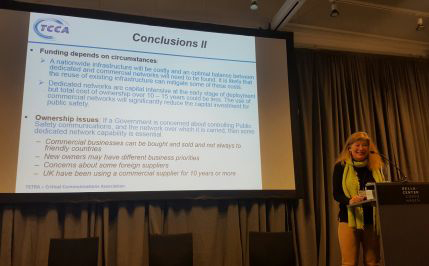The TCCA has defined the four key areas that governments looking to implement public safety networks based on LTE must consider if they are to achieve a trusted and fit for purpose service for their public safety users: spectrum, security, ownership and funding.
A new white paper, Hybrid Study - A discussion on the use of commercial and dedicated networks for delivering Mission Critical Mobile Broadband Services, from the TCCA explores these topics to assist government organisations and those responsible for public safety mobile communications to consider the most appropriate solution for critical broadband. The paper uses the term hybrid infrastructure to describe a combination of dedicated infrastructure and service provided by commercial mobile network operators.

Barbara Held, TCCA board member, presenting the white paper's conclusions at Critical Communications Europe
Commercial mobile network operators already offer broadband service, and can deliver mobile broadband to public safety services. Many public safety organisations are already taking advantage of this capability but only for non mission-critical applications, with the traffic carried by a ‘best efforts’ commercial service.
However, for safety critical applications such as dispatching ambulances, passing details of terrorist suspects and dealing with major incidents, the TCCA states that it is essential that networks are employed that are suited to mission-critical communication, taking these four key areas into account:
Spectrum: The availability of spectrum is essential to enabling choice in the provision of broadband data services. For a public safety operator to build its own infrastructure anywhere in the country, it will be necessary to obtain suitable spectrum. Those responsible for public safety communications must review the opportunities for obtaining spectrum and engage with the appropriate government ministries and the national regulator to establish how spectrum can be made available for public safety.
Security: Secure communications are essential to enable confidential information to be passed safely over the network, and broadband data services will likely carry more confidential information than existing voice networks. Security mechanisms are being designed into future LTE standards, but the standard is not currently at a security level to match purpose-designed PMR standards. A review of the security arrangements available in LTE systems, and in any commercial network that is used, should be undertaken by suitably qualified staff.
Ownership: As with any commercial business, commercial mobile networks are subject to being bought and sold. Such transfers of ownership may be to companies in any region of the world. Some governments are cautious about critical national infrastructure being owned by foreign companies. Those responsible for public safety communications should consider the national government policy regarding foreign ownership and operation of telecommunications infrastructure.
Funding: If spectrum has been secured, the degree to which dedicated infrastructure can be built will be dependent on funding. Nationwide infrastructure will be relatively costly in many countries and an optimal balance between dedicated and commercial networks will need to be found. The use of commercial networks can significantly reduce the capital investment for public administrations and the time required to implement public safety services. The use of commercial networks will, however, incur ongoing service charges. It is likely that the reuse of existing base station sites and sharing infrastructure can mitigate some of these costs.
There is no doubt that mobile broadband services are likely to bring significant benefits for many public safety users, enabling faster and more targeted responses to incidents, as well as efficiency savings. Commercial broadband networks are already operational in many countries and rollout accelerates as new spectrum is made available.
There is no simple answer to how mobile broadband should be provided to public safety users. Every nation will be in a different part of the lifecycle of their current communications networks and each will have a different set of local circumstances.


